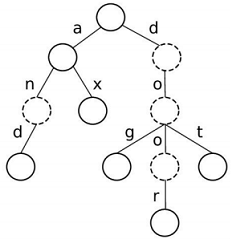Reference no: EM131269818
Introduction to Computer Science Assignment
Question 1: Implementing Autocomplete with a Trie
In this question, you will work on the problem of storing a set of n words (also called keys) in a tree data structure, and a method for efficiently finding all the words that contain a given prefix. By word or key here, we just mean a string formed from some set of ASCII characters. (If you are unfamiliar with ASCII, see https://www.asciitable.com/. ASCII encodes text using one byte or 8 bits per character.)
You should be familiar with the above problem through the autocomplete feature found on some cell phones, web forms, Eclipse. For instance, if you type in "aar", then autocomplete may suggest aardvark, aardvarks, aardwolf, aardwolves, aargh.
Trie Data Structure
A trie is a type of rooted tree used to efficiently index keys by storing their prefixes. (The term trie comes from the word "retrieval". It is sometimes pronounced "try" although many people pronounce it the same as "tree".) The main property of a trie is that each edge corresponds to a character. Thus the path from the root of the trie to any node in the trie defines a string. The string defined by each node is a prefix of all strings defined by the descendents of that node.
Below is an example trie. It contains the following keys: a, and, ax, dog, door, dot. You will note that the dashed nodes correspond to prefixes in the trie that are not in our list of keys (an, d, do, doo). The trie must also keep track of this distinction by storing for each node whether it corresponds to a key or not.
Note that if C is the set of all possible characters defined at the edges, then each node can have at most k = | C | children, where the | C | notation just means the number of elements in set C.

What You Need To Do
Read the provided code (Trie.java, AutoComplete.java), including the comments which explain what the various methods do. This will take you some time, so go slow and read the code carefully. Note that the Trie class has a private inner class TrieNode.
For the Trie class, fill in the missing code for the following methods:
- createChild(), toString() for the inner class TrieNode
- getPrefixNode(), insert(), contains(), getAllPrefixMatches()
We suggest you implement them in the order listed above. You may write helper methods, but if you do then add a comment explaining what you are doing so that the grader can easily follow.
You should use Java String methods length() and charAt(). But you may not use String searching methods such as String.startsWith(), String.substring(), etc. The point of the assignment is for you to organize and compare strings use a trie data structure.
Submit only the file Trie.java as a zip file. Use the AutoComplete.java file to test your code, but do not submit this tester file.
Question 2: Running time analysis of Tries
Here you will analyze the complexity of two methods, namely loadKeys() and contains().
Suppose you are given a set of K keys, where each key is of length at most L characters. Let the keys be represented by a trie T1 as implemented in Question 1. Let C be the maximum number of children of a node. Although C is a constant NUMCHILDREN in the code, we are asking you to treat it as a variable in these questions.
Answer the following questions. In each case, give the tightest bound. For example, if the bound was O(L) and you wrote O(KL), then your answer would not be the tightest bound. In addition, you must provide a short written justification for your answer.
In each case, your answer should be in terms of the variables K, L, C.
1) What is the O( ) bound of loadKeys() on T1?
2) What is the O( ) bound of contains() on T1?
In the TrieNode inner class, the children of a node is implemented using an array of size C. In many tree data structures, however, the set of children is implemented using a linked list. Suppose we were to modify the TrieNode inner class so that each node's children were implemented using a linked list. Let T2 denote the modified trie data structure.
3) What is the O( ) bound of loadKeys() on T2?
4) What is the O( ) bound of contains() on T2?
We next compare the runtime of tries to the runtimes of binary search trees (BST). Consider a BST data structure that stores the same set of K keys. Each node in this BST would correspond to a key, such that the left (or right) child of each node is lexicographically smaller (or bigger) than its parent. Note there is no prefix representation with a BST.
Note that the running time of operations on a BST depends on how "balanced" the tree is. (Roughly speaking, a tree is well balanced if the number of descendents of each left child is approximately the same as the number of descendents of each right child.)
5) What is the O( ) bound of loadKeys() for a BST?
6) What is the : ( ) bound of loadKeys() for a BST?
7) What is the O( ) bound of contains() for a BST?
8) What is the : ( ) bound of contains() for a BST?
Assume that these methods perform the same role as they do for tries i.e. loadKeys() populates a BST, and contains() searches for a key in BST.
Hint: Comparing the lexicographic order of two strings of length L requires at least one and at most L comparisons.
What You Need To Do
Submit a text file A3Q2.txt with answers to the questions. Feel free to write Omega( ) instead of Ω( ). Include this text file in your A3.zip folder which you submit.
Attachment:- Assignment.zip